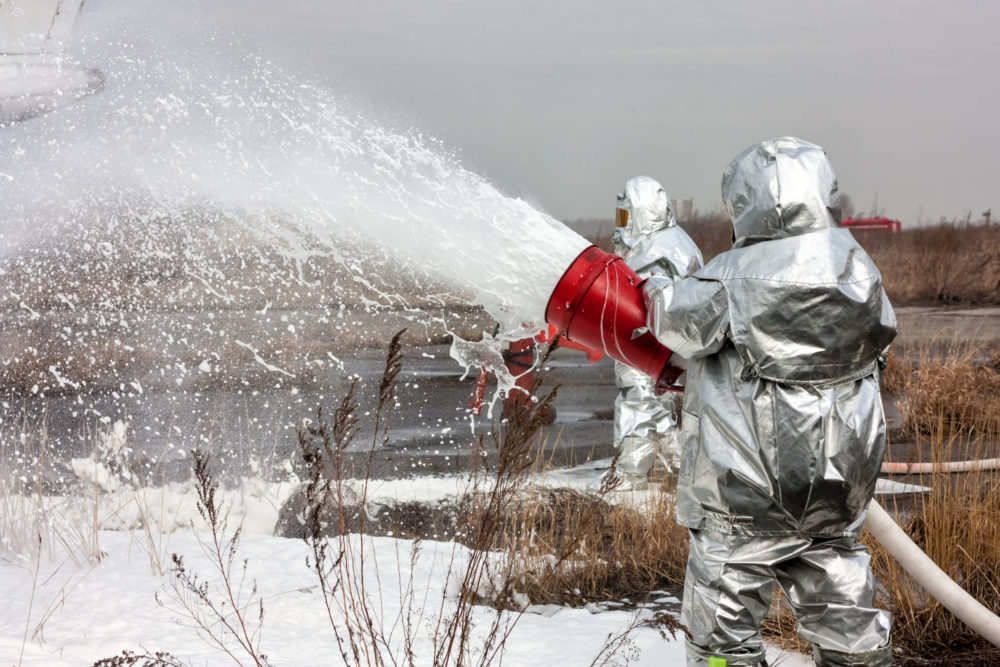Eligible for a Firefighting Foam lawsuit?
Fire Fighter Foam Used On Military Bases Contaminated Nearby Drinking Water Supply, Lawsuit Claims

A number of chemical and safety equipment manufacturers face a product liability lawsuit over fire fighter foam used on military bases, which led to widespread contamination of surrounding water supplies.
The complaint (PDF) was filed by Jane Toner in the U.S. District Court for the District of South Carolina on May 22, indicating that residents who lived near the military bases where the fire retardant foam was used have been exposed to toxic chemicals that leached into the water supply, causing an increased risk of cancer and other serious health issues.
The lawsuit names 3M Company, Tyco Fire Products, Chemguard, Buckeye Fire Equipment, National Foam, Inc. Kidde-Fenwal, Inc. Dynax Corporation, E.I. Du Pont De Nemours and Company, the Chemours Company and Corteva, Inc. as defendants, indicates the companies manufactured, distributed and sold toxic aqueous film-forming foam (AFFF) used for decades by the U.S. Navy and the Pennsylvania Air National Guard on ships and military bases.

Firefighting Foam Lawsuits
Lawyers are reviewing aqueous film forming foam (AFFF) lawsuits for firefighters, military personnel and individuals who developed cancer or other health issues from exposure to toxic firefighting foam chemicals.
Learn More SEE IF YOU QUALIFY FOR COMPENSATIONTwo of those bases include the Willow Grove Naval Air Station Joint Reserve Base in Horsham Township, and the former Naval Air Warfare Center in Warminster Township, both in Pennsylvania.
“Residents in the area near the Bases, including Plaintiff, obtained and continue to obtain their drinking water predominantly from groundwater pumped from either municipal or private wells,” Toner’s lawsuit states. “For decades, residents near the Bases and their children in their homes, schools, gyms, parks, restaurants, etc. have been drinking, and eating food prepared with, water laced with dangerous chemicals, namely, perfluorooctane sulfonate (PFOS) and perfluorooctanoic acid (PFOA).”
The lawsuit indicates Toner, who lived in Horsham for years, suffered injuries, diseases, bruises, scarring and contusions as a result of exposure to fire fighting foam chemicals in her drinking water.
Firefighting Foam Health Concerns
Aqueous film-forming foam (AFFF) has been used at military bases and by some civilian fire fighting organizations throughout the United States to fight petroleum-based fires which cannot be controlled or subdued by water alone.
In addition to firefighting foams, PFASs are chemical substances used to manufacture a number of products, including food packaging materials, pizza boxes, popcorn bags, fabrics, nonstick cooking pans, and other products. The firefighting foam has been regularly used at military bases nationwide over the past decade during routine fire extinguishing exercises, and is increasingly used by civilian firefighters.
The chemicals are projected to take thousands of years to degrade, and past studies have shown their ability to enter and stay in the environment and human body through the air, dust, food, soil, and water. Previous U.S. Centers for Disease Control and Prevention (CDC) studies have shown PFAS chemicals primarily settle into the blood, kidney and liver, and could likely be detected in the blood of 98% of the U.S. population.
PFAS were first introduced into the manufacturing industry in the 1940’s, because of their ability to resist heat, grease, stains, and water. However, since then the chemicals have been linked to a myriad of adverse health effects including liver damage, thyroid disease, decreased fertility, high cholesterol, obesity, hormone suppression, and cancer.
In June 2019, a federal investigation found that PFAS chemicals are commonly found in numerous food products, including meats, seafood, chocolate, cake and other products. However, the FDA released a statement indicating that the levels found do not raise health concerns, based on the best available science.
According to findings published in the Journal of the American Medical Association in 2012, exposure may also suppress the immune system and limit the ability of the body to create antibodies in response to childhood vaccines.
In December 2018, all fire fighter foam lawsuits filed in federal courts nationwide were centralized in the U.S. District Court for the District of South Carolina for pretrial proceedings.






0 Comments